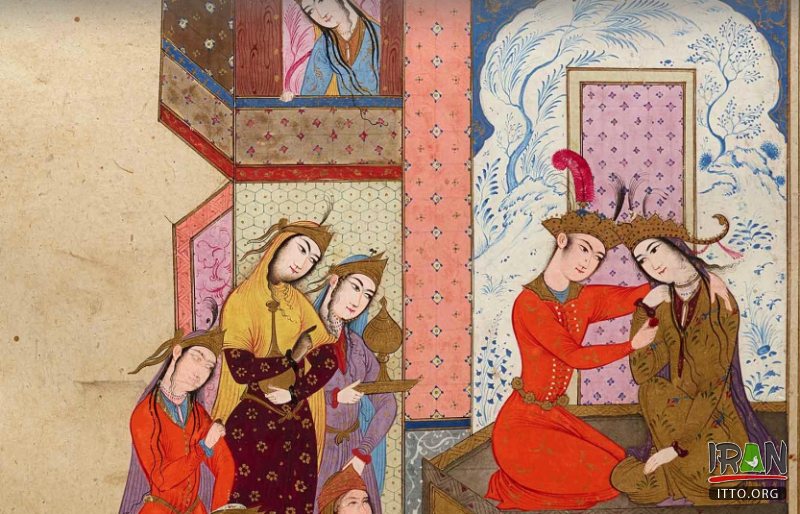Persian art and Literature or Iranian art has one of the richest art heritages in world history and has been strong in many media including architecture, painting, weaving, pottery, calligraphy, metalworking and sculpture.
At different times, influences from the art of neighbouring civilizations have been very important, and latterly Persian art gave and received major influences as part of the wider styles of Islamic art.
Rock art in Iran is its most ancient surviving art. Iranian architecture is covered at that article. From the Achaemenid Empire of 550 BC–330 BC for most of the time a large Iranian-speaking state has ruled over areas similar to the modern boundaries of Iran, and often much wider areas, sometimes called Greater Iran, where a process of cultural Persianization left enduring results even when rulership separated. The courts of successive dynasties have generally led the style of Persian art, and court-sponsored art has left many of the most impressive survivals.
In ancient times the surviving monuments of Persian art are notable for a tradition concentrating on the human figure (mostly male, and often royal) and animals. Persian art continued to place larger emphasis on figures than Islamic art from other areas, though for religious reasons now generally avoiding large examples, especially in sculpture. The general Islamic style of dense decoration, geometrically laid out, developed in Persia into a supremely elegant and harmonious style combining motifs derived from plants with Chinese motifs such as the cloud-band, and often animals that are represented at a much smaller scale than the plant elements surrounding them. Under the Safavid dynasty in the 16th century this style was used across a wide variety of media, and diffused from the court artists of the shah, most being mainly painters.
Persian literature:
Persian literature, body of writings in New Persian (also called Modern Persian), the form of the Persian language written since the 9th century with a slightly extended form of the Arabic alphabet and with many Arabic loanwords. The literary form of New Persian is known as Farsi in Iran, where it is the country's official language. it is written with a Cyrillic alphabet by Tajiks in Tajikistan and Uzbekistan. For centuries New Persian has also been a prestigious cultural language in western Central Asia, on the Indian subcontinent, and in Turkey.
Iranian culture is perhaps best known for its literature, which emerged in its current form in the 9th century. The great masters of the Persian language Ferdowsi, Neẓami Ganjavi, Ḥafeẓ Shirazi, Jam, and Moulana (Rumi), continue to inspire Iranian authors in the modern era.
Persian literature was deeply influenced by Western literary and philosophical traditions in the 19th and 20th centuries yet remains a vibrant medium for Iranian culture. Whether in prose or in poetry, it also came to serve as a vehicle of cultural introspection, political dissent, and personal protest for such influential Iranian writers as Sadeq Hedayat, Jalal Al-e Ahmad, and Sadeq-e Chubak and such poets as Sohrab Sepehri, Mehdi Akhavan Saales, Ahmad Shamlu and Forough Farrokhzad.
Persian Traditional Music:
Iranian classical music consists of characteristics developed through the country's classical, medieval, and contemporary eras. Due to the exchange of musical science throughout history, many of Iran's classical melodies and modes are related to those of its neighboring cultures. Iran's classical art music continues to function as a spiritual tool, as it has throughout history, and much less of a recreational activity. It belongs for the most part to the social elite, as opposed to the folkloric and popular music, in which the society as a whole participates. However, the parameters of Iran's classical music have also been incorporated into folk and pop music compositions.
Indigenous Iranian musical instruments used in the traditional music include string instruments such as the chang (harp), qanun, santur, rud (oud, barbat), tar, dotar, setar, tanbur, and kamanche, wind instruments such as the sorna (zurna, karna), ney, and neyanban, and percussion instruments such as the tompak, kus, daf (dayere), naqare, and dohol.[citation needed] Some instruments, such as the sorna, neyanban, dohol, and naqare, are usually not used in the classical repertoire, but are used in the folk music. Up until the middle of the Safavid Empire, the chang was an important part of Iranian music. It was then replaced by the qanun (zither), and later by the western piano.
The tar functions as the primary string instrument in a performance. The setar is especially common among Sufi musicians. The western violin is also used, with an alternative tuning preferred by Iranian musicians. The ghaychak, that is a type of fiddle, is being re-introduced to the classical music after many years of exclusion.


